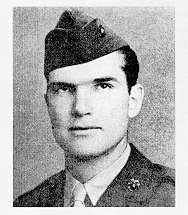William D. Halyburton Jr.
William David Halyburton Jr. (October 2, 1924 – May 10, 1945) was a United States Navy hospital corpsman who was killed in action during World War II while assigned to a Marine Corps rifle company. He was posthumously awarded the nation's highest military decoration for valor, the Medal of Honor, for heroic actions "above and beyond the call of duty" on May 10, 1945, during the Battle of Okinawa.
William David Halyburton Jr. | |
|---|---|
 PhM2 William Halyburton Jr., U.S. Navy Reserve Medal of Honor recipient | |
| Born | August 2, 1924 Canton, North Carolina |
| Died | May 10, 1945 (aged 20) Okinawa, Japan |
| Place of burial | National Memorial Cemetery of the Pacific, Honolulu, Hawaii |
| Allegiance | |
| Service/ | |
| Years of service | 1943–1945 |
| Rank | Pharmacist's Mate Second Class |
| Unit | 2nd Battalion, 5th Marines, 1st Marine Division |
| Battles/wars | World War II • Battle of Okinawa † |
| Awards | Medal of Honor Purple Heart Medal |
Biography
Born on August 2, 1924, in Canton, North Carolina, Halyburton attended Canton Presbyterian Church before moving to Wilmington, North Carolina where he graduated from New Hanover High School. He entered seminary at Davidson College in Davidson, North Carolina, but left to enlist in the U.S. Naval Reserve on August 4, 1943.[1][2]
He completed recruit training at the Naval Training Center, Bainbridge, Maryland, and was promoted to seaman second class in the fall. Remaining in the area, he attended the U.S. Navy Hospital Corps School and was rated a pharmacist's mate third class upon graduation. He studied at other training centers and was advanced to pharmacist's mate second class on August 1, 1944.[3] After completing the Fleet Marine Force Field Medical Service School at Camp Pendleton, California for combat field training, he departed on December 14 for the Pacific war zone on board the transport USS General M. M. Patrick and joined the 2nd Battalion, 5th Marine Regiment, 1st Marine Division.[3][1]
On April 1, 1945, Halyburton landed with the 5th Marines on Okinawa. On May 10, 1945, Halyburton was serving with a Marine rifle company against the Japanese on Okinawa when they suffered numerous casualties after advancing into Awacha Draw. Exposed to enemy fire, he rushed to aid a fallen Marine the furthest away. Shielding the man with his own body while administering aid, Halyburton was mortally wounded. For this action, he was posthumously awarded the Medal of Honor.[1] He was one of two people from Haywood County, North Carolina, to receive the medal in World War II, the other being Max Thompson.[2]
Halyburton is buried at the National Memorial Cemetery of the Pacific at Honolulu, Hawaii.[1]
Medal of Honor citation
Halyburton's official Medal of Honor citation reads:
The President of the United States takes pride in presenting the MEDAL OF HONOR posthumously to
PHARMACIST MATE SECOND CLASS WILLIAM D. HALYBURTON JR.
UNITED STATES NAVY RESERVE
for service as set forth in the following
CITATION:
For conspicuous gallantry and intrepidity at the risk of his life above and beyond the call of duty while serving with a Marine Rifle Company in the 2d Battalion, 5th Marines, 1st Marine Division, during action against enemy Japanese forces on Okinawa Shima in the Ryukyu Chain, 10 May 1945. Undaunted by the deadly accuracy of Japanese counterfire as his unit pushed the attack through a strategically important draw, Halyburton unhesitatingly dashed across the draw and up the hill into an open fire-swept field where the company advance squad was suddenly pinned down under a terrific concentration of mortar, machinegun and sniper fire with resultant severe casualties. Moving steadily forward despite the enemy's merciless barrage, he reached the wounded marine who lay farthest away and was rendering first aid when his patient was struck for the second time by a Japanese bullet. Instantly placing himself in the direct line of fire, he shielded the fallen fighter with his own body and staunchly continued his ministrations although constantly menaced by the slashing fury of shrapnel and bullets falling on all sides. Alert, determined and completely unselfish in his concern for the helpless marine, he persevered in his efforts until he himself sustained mortal wounds and collapsed, heroically sacrificing himself that his comrade might live. By his outstanding valor and unwavering devotion to duty in the face of tremendous odds, Halyburton sustained and enhanced the highest traditions of the U.S. Naval Service. He gallantly gave his life in the service of his country.[4]
Honors
The USS Halyburton (FFG-40), a guided missile frigate commissioned on January 4, 1984, was named in his honor. A number of other military structures have been named for him, including Halyburton Quarters in Charleston, South Carolina; a road at the National Naval Medical Center in Bethesda, Maryland; and a barracks at Naval Air Station Pensacola, Florida.[2]
A public park in Wilmington is named for him,[5] and in his birth city of Canton, Halliburton Street was re-spelled Halyburton Street in his honor.[2]
References
- This article incorporates text from the public domain Dictionary of American Naval Fighting Ships.
- "US People - Halyburton, Jr., William D., Pharmacist's Mate Second Class, USNR". Washington, DC: Naval History and Heritage Command. March 4, 2010. Retrieved August 10, 2010.
- Stockton, Ron (November 11, 2010). "2 Haywood County World War II heroes among few to get Medal of Honor". Asheville Citizen-Times. Asheville, North Carolina. Archived from the original on November 13, 2010.
- Marine Corps History Division http://www.mcu.usmc.mil/historydivision/Pages/Who's%20Who/G-I/Halyburton_WD.aspx
- "Medal of Honor Recipients - World War II (G–L)". Medal of Honor Citations. United States Army Center of Military History. August 3, 2009. Retrieved November 12, 2010.
- "Halyburton Park". Wilmington, NC: City of Wilmington. Retrieved August 10, 2010.